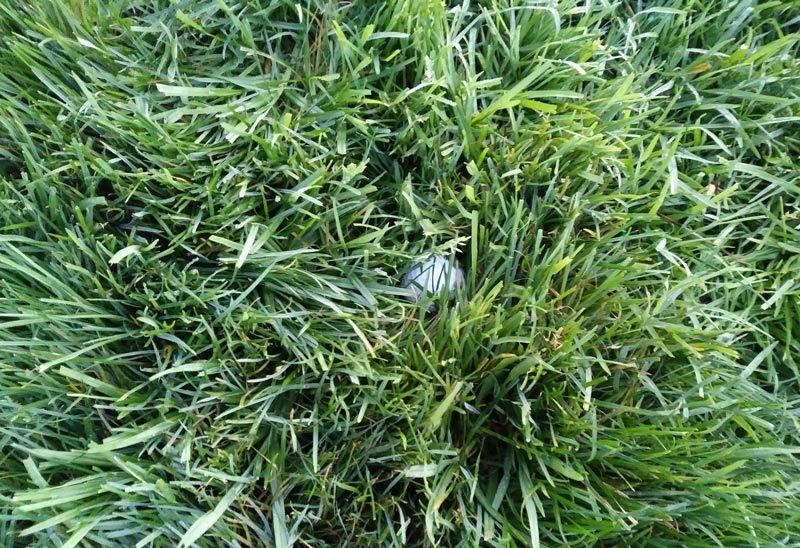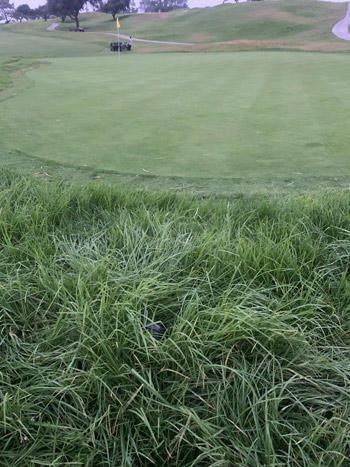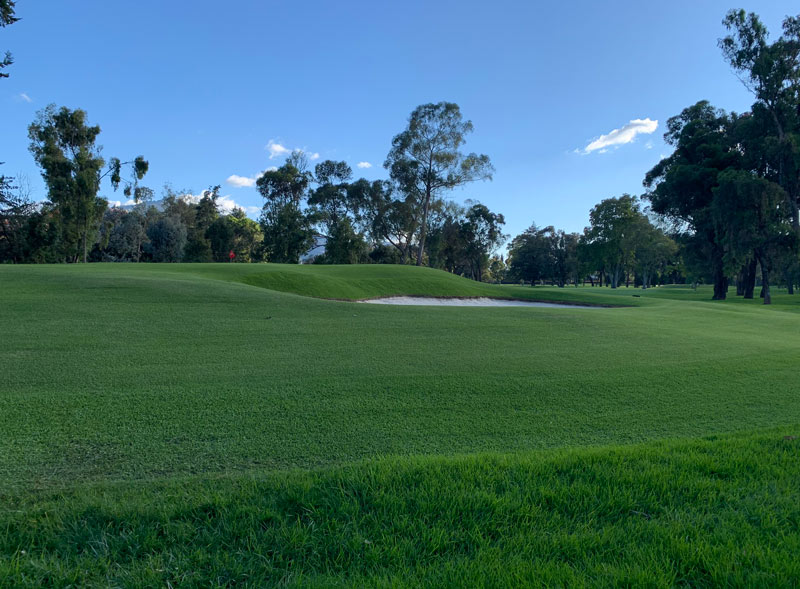
An errant shot in the kikuyugrass rough off the sixth fairway of Torrey Pines’ South Course on June 16. Photo by Howard Richman
In USGA news conferences earlier this week, Jordan Spieth said he hoped the U.S. Open spotters bring their A game. Patrick Reed suggested an unusual club choice. And Xander Schauffele seemed to have a good grasp of golf course superintendent lingo.
“I’m no agronomist,” Schauffele said, “but there’s probably anywhere from three to six different kinds of grasses on the property, and depending on where you miss it (a shot), you can either get really lucky or really unlucky.”
All three pros had one grass in particular on their minds as they were preparing for the 121st U.S. Open at Torrey Pines’ South Course in San Diego, which kicked off this morning. Kikuyugrass (overseeded with ryegrass) dominates the rough at Torrey Pines, and it even has burly basher Bryson DeChambeau contemplating a strategy for handling it.
“For the most part, I’m going to be trying to bomb it as much as possible and try to gouge it out when I don’t hit it in the fairway,” DeChambeau said.
Native to East Africa, kikuyugrass (Pennisetum clandestinum) derives its common name from the Kikuyu people, who live in the area around Mount Kenya. It has been introduced in many areas across Africa, North and South America, Australia, Asia, and the Pacific. Kikuyugrass has an aggressive growth habit that has led to its classification as a noxious weed by the U.S. federal government and several states. Nonetheless, kikuyugrass seed is still produced in California, Arizona and Texas — with some restrictions — and seed and sod can be planted in several counties in Southern California. It is well adapted to a Mediterranean-type climate and thrives on golf courses, particularly in Southern California and in inland valleys and coastal areas as far north as San Francisco.
Editor’s note: Learn more about kikuyugrass and its benefits and drawbacks in Kikuyugrass: Out of Africa.
Golfers like Spieth rarely play on kikuyugrass, with one of the exceptions being the PGA Tour’s Farmers Insurance Open at Torrey Pines, which takes place in late January when the kikuyugrass is mostly dormant in the cooler and overcast conditions. But when players of Spieth’s ilk hit their shots into kikuyugrass rough — the course also has kikuyugrass fairways — in June, there’s a chance the grass will essentially swallow the ball, hence Spieth noting the need for spotters to be on high alert to pinpoint balls’ landing spots.
Reed, meanwhile, tested out the kikuyugrass during a practice round this week and discovered no two lies are guaranteed to be similar. “It’s nasty. On hole nine, I threw two balls, and they landed just about the same spot. One hopped into the rough, and one of them kind of got in the kikuyu and sat up because it’s so thick, actually sat high, where I felt like I could almost hit driver off of it. The other one was maybe 3 feet from it and sank to the bottom,” Reed said.

Right: Can you spot the Yeti (the drink container, not the folklore creature) in the nearly 8 inches of kikuyugrass at Torrey Pines? This photo was taken by Torrey Pines crew member Brian Manning when the facility wasn’t in prep mode for a professional tournament.
Kikuyugrass certainly seems to have quite a personality. “It tends to take over and do its own thing,” says Torrey Pines assistant superintendent Travis Rebischke, a five-year GCSAA member who recalls a time he encountered a tiny strand of kikuyugrass in a bunker. “You keep pulling it and pulling it. ... It’s like a rope, and it ends up being 3 feet long. It’s like a piece of thread coming off a T-shirt.”
Prepping the kikuyugrass rough for the U.S. Open started immediately following the Farmers Insurance Open. After that event, the rough was mowed down to 1 inch for about a month to maximize sunlight and increase soil temperatures. Irrigation was drastically reduced to stress the cool-season turfgrasses competing against the kikuyu. Doing so allowed the kikuyu to begin growing more quickly and outcompete the ryegrass and Poa annua. Slowly, the agronomy team increased mowing height, made additional fertilizer applications, and increased supplemental watering to promote kikuyu growth and force the transition from those cool-season grasses.
At that point, cart use for patrons at the municipal facility was being regulated, and it was ultimately stopped in early May. The kikuyu rough was fertilized again about six weeks prior to the championship, and play was halted June 7. An increase in hand-watering began on and around greens, which are kikuyugrass-adjacent. Lee Westwood, who made a run and finished third in the 2008 U.S. Open at Torrey Pines, said this week he doesn’t remember those surrounds being as thick then as they are now.
On Wednesday, Torrey Pines senior superintendent Rich McIntosh felt more relieved than he had in a while about the kikuyugrass rough. “Two or three weeks ago, I was a little concerned. It was cloudy, and we didn’t have a whole lot of sunlight,” says McIntosh, a GCSAA Class A superintendent and 11-year member of the association. “Since then, we’ve been fortunate enough to have warm weather, unusually warm for this time of year, and a lot of it (kikuyugrass) has come up. It’s dense and thick.”
Editor’s note: Hear from Torrey Pines Golf Course caretakers past and present, get to know the South Course, and check out exclusive behind-the-scenes videos of U.S. Open prep in Team Torrey Pines and the 2021 U.S. Open.
The process of preparing for a pro tournament on kikuyugrass is familiar for maintenance team volunteer Eamonn McCarthy from Country Club de Bogota in Colombia. He has hosted a Korn Ferry Tour event on kikuyugrass at 8,500 feet above sea level. “Like here, it’s thick and wiry. I really like it, and we’re learning more about it as we go along, trial and error,” says McCarthy, a 13-year GCSAA member. “Our inputs for it are low (he does spray for large patch disease). Last year, we didn’t need a pound of nitrogen. It needs minimal water, the color is unbelievable, and it loves growing. We also have to do a lot of grinding to sharpen the reels.”
That’s a given at Torrey Pines too, where superintendent Rob Browns has a name for kikuyugrass. “Once you get used to it, you get to know its quirks,” Browns says. “You just get to know the beast.”

Kikuyugrass at Country Club de Bogota in Colombia, where Eamonn McCarthy, a volunteer at this week’s U.S. Open, is the superintendent. Photo courtesy of Eamonn McCarthy
And that’s just the way the USGA likes its U.S. Open. “It’s a native grass most people consider a weed, but it thrives on this property. It wants to be here,” says Darin Bevard, USGA director of championship agronomy, who notes that for the U.S. Open, the primary rough will be 3 inches and the secondary rough 5 inches. “Certainly, it’s serving our purpose well.”
And it’ll certainly be a topic of conversation over the next few days, as talented players could sink if they find themselves in the sea of kikuyugrass too often. Golfer Jon Rahm, who is searching for his first major title, is hoping he can avoid the dreaded surfaces. “You can actually get lucky and get some decent lies,” Rahm said, “or you can get some that it’s hard to move 5 yards. So the discrepancy is big. It’s going to happen. It’s a U.S. Open.”
Howard Richman is GCM’s associate editor.